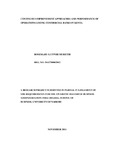| dc.description.abstract | Continuous improvement(CI) is a quality philosophy that assumes further improvements are
always possible and that processes should be continuously re-evaluated and improvements
implemented (Juergensen, 2005).CI is also essentially a quality journey that is “never ending”
(Oakland,2007).There are 43 commercial banks operating in Kenya (CBK, 2013) who are
currently facing many challenge including competition from the telecommunications companies
e.g. the advent of M-pesa and rapid growth of the micro finance sector hence the need to
differentiate themselves so that they remain a preferred choice for their customers.CI can be one
of the strategies through process improvement and cost reduction and faster customer turnaround
time on the service .
The objective of the study was to find out the CI approaches adopted by commercials banks’ and
the impact CI has on performance of operations among these banks. The research was carried out
through a descriptive survey research. Data collected was both primary and secondary; collection
of secondary data was from banks publications of their quarterly financial results while primary
data was a structured questionnaire to the head of retail operation or chief operating officer
(COO) /equivalent in all the 43 commercial banks. Data analysis was through content analysis of
the questionnaire and descriptive statics for the secondary data extracted from financial reports
from the banks.
A total of 43 respondents were involved in the study however 53% response rate was achieved.
The study found out that 38% of the respondents used balanced score card,18% TQM,17%
illustrated as Others which included traditional or business reengineering and 26 % of
respondents where Non specific on the CI approach used. Cost to income ratio (CIR) also known
as efficiency ratio was used as the performance measure where banks who had adopted a CI
approach had a mean of 54 while Other category had mean of 64 and non specific 66. A CIR of
below 50 is recommended and one high than 55 is considered risky
Though the study was not conclusive because of the non specific respondents which affected the
representation sample, Conclusions drawn on this study is that over 50 % of commercial banks
have some form of CI approach. Also, CI adoption has a positive impact to the performance of
operations; however though the banks have implemented CI full adoption has not been reached.
Recommendation : banks should be encouraged to fully adopt CI approaches that they deem fit
in their organizations operations so as to leverage on the benefits of CI including waste
elimination, cost reduction through process improvement, customer turnaround time which
would improve their customer service. | en_US |

